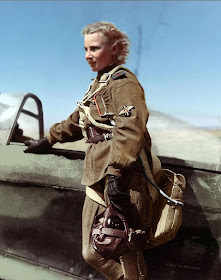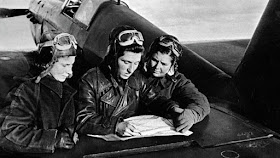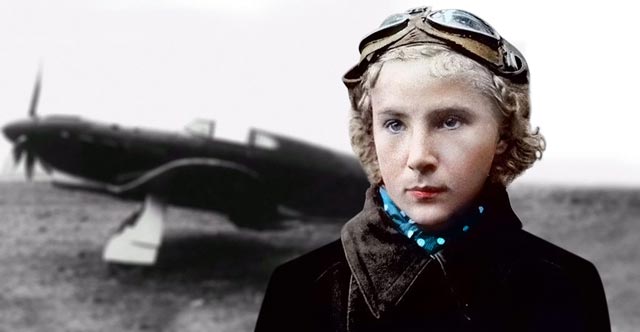It is a little-known fact that there were female fighter aces during World War II. This article is about the
two female fighter aces of the Red Air Force, Lydia Litvyak and Yekaterina Budanova.
The Soviet Union had a number of excellent female pilots. At the absolute nadir of Soviet fortunes during World War II, famed Russian pilot Marina Raskova suggested the formation of all-female air force units. Joseph Stalin then personally ordered the formation of several air units specifically intended to be composed entirely of women. By Order No. 0099, dated 8 October 1941, the Stavka (Soviet high command) that Stalin led created three all-female units in the Soviet Air Force.
 |
| Marina Raskova on a stamp issued on the centenary of her birth in 2012. |
These all-female units were in Aviation Group 122. This group was composed of the No. 586 Aviation Regiment (Yak-1 fighters), No 587 Regiment (later the 125th Guards Dive Bomber Regiment flying Pe-2 bombers), and No. 588 Regiment (later the 46th Guards Night Bomber Regiment, flying Polikarpov Po-2 night bombers). Stalin never rescinded his order and the all-female units went into action even as the Soviet fortunes improved.
 |
| The Night Witches got down and dirty in the mud just like the male pilots. Here, a bunch of Night Witches pushes their truck out of the ubiquitous Russian mud. |
The Night Witches
The most famous (or notorious, depending on your point of view) female pilots flew in the
Night Witches, the all-female No. 588 Regiment that flew bombers. The Night Witches unit (a nickname given to them by the Germans) flew over 23,000 missions in obsolete biplane bombers. While not conducting a strategic bombing operation, the Night Witches unit flew harassing missions at night in order to disrupt the Germans’ sleep while causing a little damage.
The Night Witches regiment was considered a success and produced 24 Heroes of the Soviet Union (there was another handful in the 587th Regiment). This was the ultimate accolade, equivalent to the British Victoria Cross or the US Medal of Honor. Receipt of this award granted an annual stipend, placement of a bust of the recipient in his or her home town, and various other highly desirable emoluments.
 |
| A restored Polikarpov Po-2. |
I mention the Night Witches because they were the female pilots most people are probably most familiar with. Also, it is to show that female pilots were a very real phenomenon in the Soviet Union and not just a gimmick. Now, before anyone gets excited and defensive about this, no, the female pilots did not win the war all by themselves and were more of an adjunct to the main forces. They were not the core of the Red Air Force and were viewed with some skepticism even by their fellow male pilots. Female pilots did serve a useful function and performed well as part of a team, often operating together or as the "wingmen" (wing women?) of established male pilots.
The Germans considered the female Soviet pilots "unnatural." A legend that may be true grew that they would shoot female Red Air Force pilots on sight.
There apparently were two Soviet female aces, and at the very least one. By “ace,” we use the standard definition of five aerial kills against the enemy. These two ladies followed similar career paths and perished around the same time during 1943.
 |
| Lydia Litvyak (RIA Novosti). |
Lydia Litvyak, or "Lilya"
One female ace was Lydia Vladimirovna Litvyak. She has received almost no recognition in the West largely because she died midway through the conflict and thus did not get a chance to write her memoirs or get interviewed by Western war correspondents.
Lydia Litvyak, or “Lilya” as she was known, was the real deal. She learned to fly long before the war at the age of 14. She later became a flight instructor at the Kalinin Airclub. She was 19 when the war broke out and she enlisted immediately pursuant to a 1939 law allowing women into the military. Lilya joined one of the three all-female units, the 586th (the Night Witches were the 588th). Already trained on a Yakovlev UT-1 trainer, Lilya learned to fly a military Yakovlev Yak-1.
 |
| Yak-1 fighters. Designed by Aleksandr Sergeievich Yakovlev in 1938, the Yak-1 first flew in January 1940 was built of metal and wood and the cockpit was notable for giving pilots excellent views. |
Lilya was known for maintaining a feminine appearance that was "a model of femininity and charm." She used hydrogen peroxide to bleach her hair and liked to pick flowers to put on the wings of her plane. As a result, Lilya became known as the "White Rose of Stalingrad."
In mid-1942, Lilya transferred to the 437th Fighter Regiment. This was a standard men’s unit. The 437th was based on the east bank of the Volga at Srednaia Akhtuba. She was awarded her first two kills on 13 September 1942, thus earning the distinction of becoming the first female pilot to ever shoot down enemy aircraft. One was a Junkers Ju-88, the other a Bf-109 G-2 “Gustav. She claimed another Bf 109 on 14 September (this was not officially recognized), then another Ju 88 on 27 September 1942 (this was officially recognized).
 |
| Lydia Litvyak. |
Lilya's unit began using Lend-Lease P-39 Aircobras in January 1943, but Lilya wanted to continue flying her trusted Yak. So, she transferred to the 296th Fighter Regiment (later the 73rd Guard Regiment). Lilya continued her successful flying and shot down another Ju 88 and a Bf 109 on 22 March 1943 but was wounded in the process. While Lilya managed to fly back to base, this led to a long hospital stay. After her release in May and while flying an upgraded Yak-1b fighter ("WHite 23"), Lilya quickly shot down an artillery observation balloon on 31 May 1943 after executing a lengthy flight behind enemy lines to attack the balloon from behind. Later, she shot down another Ju 88 on 16 July 1943 during the Battle of Kursk. She was credited with another Bf 109 on 19 July 1943 and again on 21 July 1943.
Lily perished on 1 August 1943 at the age of 21 on a mission over Orel while escorting some Ilyushin Il-2 Sturmovik ground-attack planes. Her No. 44 plane, as was customary for "free hunters" as they were known, bore a white lily symbol. Being recognized as a "free hunter," or able to go on your own "seek and destroy" missions as a freelancer, was the highest honor a Red Air Force fighter pilot could receive from fellow pilots.
 |
| Lilya. |
During her career, Lilya flew in 168 combat missions. She was given credit for at least five kills and possibly as many as a dozen. Lilya's remains were found in 1979 buried in the village of Dmitrievka, Shakhterski district (also known as Dmitrovka in the Cherkasy region of Ukraine). This disproved a common belief that Lilya had been taken captive, which was considered dishonorable, and thus opened her to further posthumous accolades. Senior Lieutenant Lydia Litvyak received the Hero of the Soviet Union accolade on 6 May 1990 from USSR President Mikhail Gorbachev. She since has become a sort of cult figure in some circles and there may be a film made about her life.
 |
| Yekaterina Budanova. |
Yekaterina Budanova
The other female ace was Yekaterina Vasilyevna Budanova. Yekatinera and Lilya were great friends and worked almost virtually as a team, though they did not always fly together. Yekaterina was about five years older than Lilya and in some ways guided her young friend. As the more outgoing of the two, Budanova "hardly stood out from the fellows."
A common description is that Lilya and Udanova were "complete opposites. While outgoing, though, Budanova was absolutely committed to the war effort. She wrote to her sister:
I am now devoting my entire life to the struggle against the vile Nazi creatures. If I am fated to perish, my death will cost the enemy dearly. My dear winged ‘Yak’ is a good machine and our lives are inseparably bound up together; if the need arises, we both shall die like heroes.
And, of course, that is exactly what happened.
 |
| Yekaterina Budanova. |
Like Lilya,
Yekaterina Budanova, nicknamed Kaća, learned to fly before the war. Budanova began her career with the 586th Fighter Aviation Regiment. She remained with the unit and began flying combat missions around May 1942. She later transferred to the 437th Fighter Regiment with Lilya and flew a The Lavochkin-Gorbunov-Gudkov LaGG-3 (LaGG-3) fighter.
Yekaterina also began shooting planes down in September or October 1942. Some say that she shot down a Bf 109 on 14 September 1942. There is better proof that she claimed a Ju 88 and Bf 109 on 2 October 1942. Another possible victory was a Ju 88 on 6 October 1942. She then transferred to the 9th Guards Regiment unit. Two kills of Bf 109s followed on 10 December 1942.
 |
| Yekaterina Budanova. |
In January 1943, Yekaterina transferred to the 296th Fighter Aviation Regiment (73rd Guards Regiment) along with Lilya so that she could continue flying Yaks. She shot down a Focke-Wulf 190 near Rostov on 10 February 1943, then a Bf 109 on 9 March 1943. She shared the destruction of Bf 109 on 30 May 1943. By July 1943, she officially had 11 claims.
Finally, after shooting down one Bf 109 (her undisputed fifth solo victory) and damaging another, Yekaterina took heavy fire near Antratsit in Luhansk Oblast on 19 July 1943. The plane caught on fire. Budanova crash-landed in the no-man’s land (aptly named this time, no?) between the two sides. However, Yekaterina did not manage to get out of her Yak and perished as her plane burned up at the age of 26. She is buried on the outskirts of the village of Novokrasnovka in the Donetsk region, Ukraine (also near Mariupol). Her plane also bore the white lilies of a "free hunter."
Yekaterina was posthumously awarded the title Hero of the Russian Federation on 1 October 1943, missing out on the title Hero of the Soviet Union only because the Soviet Union at that point no longer existed.
 |
| Lydia Litvyak, Yekaterina Budanova, and fellow pilot Maria Kuznetsova plan a mission beside a Yak-1 fighter (RIA Novosti). |
Conclusion
Fellow Soviet ace Vladimir Lavrinjenko recalled Budanov and Litvjak this way:
Kaća was lively and cheerful, and Lydia Litvjak was the opposite - thoughtful and silent. The girls were real friends, but Kaća always had the last word.
So, although Lilya apparently wound up with more victories and more posthumous fame, the relationship between the two women was quite the opposite. Yekaterina was the planner and Lilya more of the follower.
 |
| Lilya remains the top female ace of all time. |
With both Lilya and Ekaterina, there is some controversy about their exact number of victories. The Soviets were not quite so thorough about counting and verifying aerial victories as the Germans or the Western Allies, though they definitely kept score. However, most sources agree that both were awarded credit for at least five victories, with the true number probably closer to a dozen for each woman. There seems little question that at the very least Lilya was a true ace in any common understanding of the term. As far as I am aware, these were the only two female aces of World War II.
 |
| Budanova and Litvyak in 1943, not long before their deaths. |
2020














Great for all the women of the world.
ReplyDelete